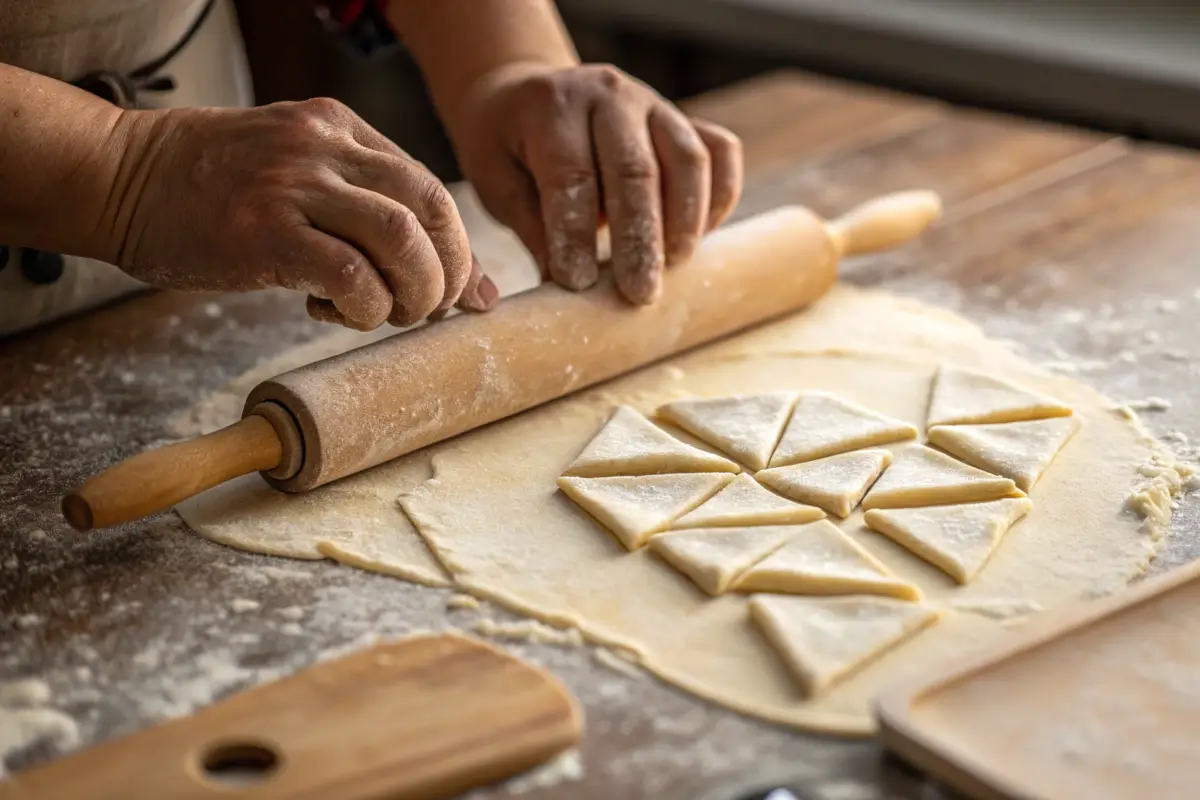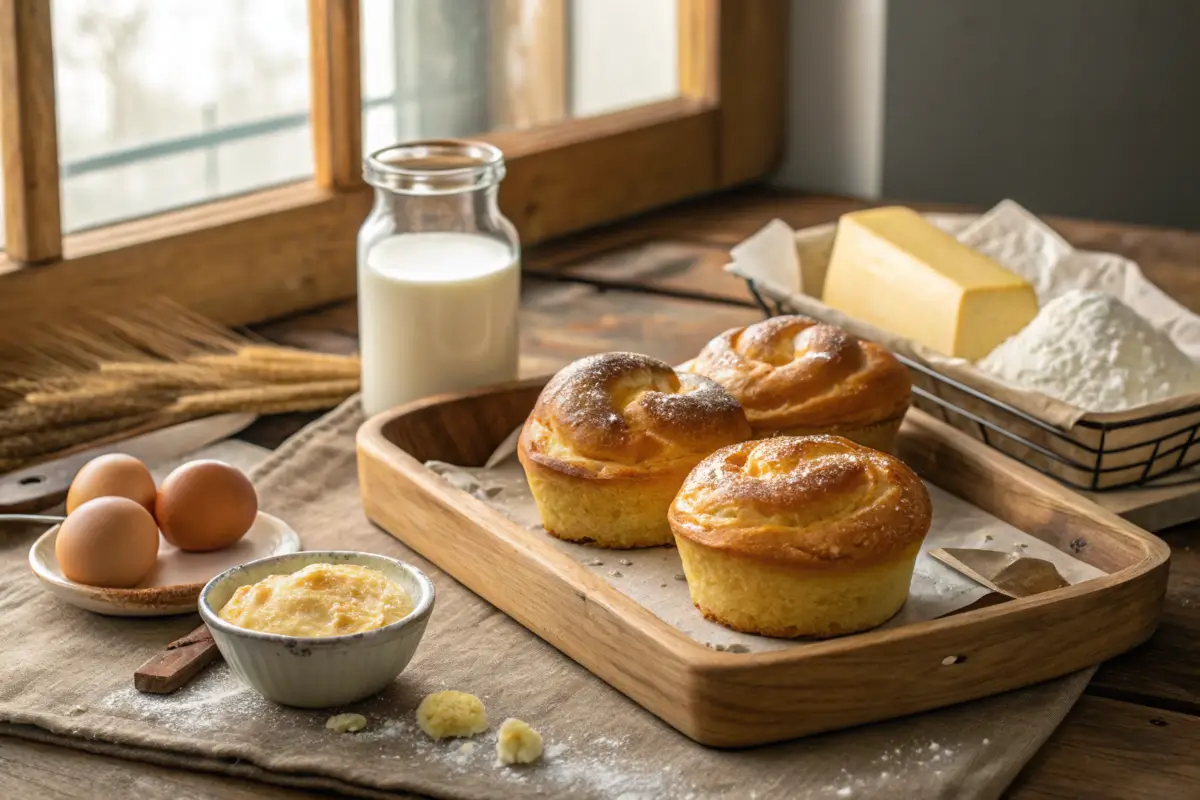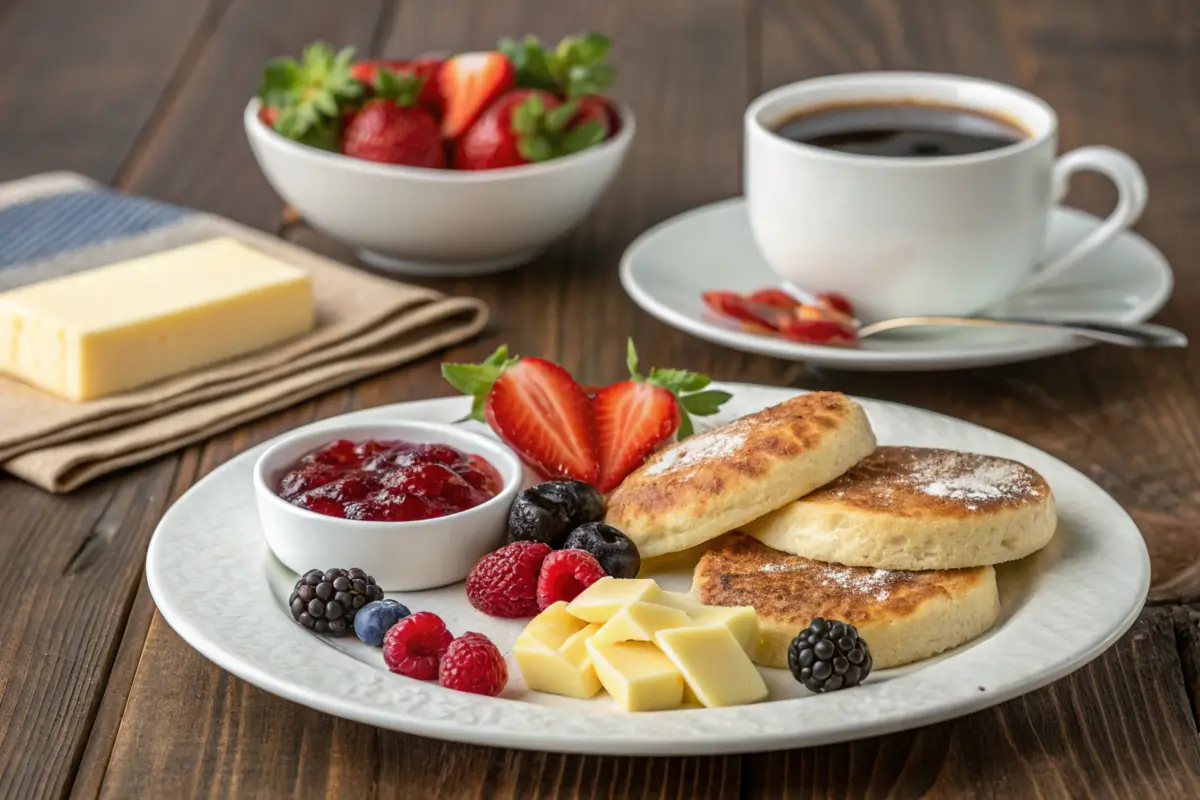Swiss Gipfeli, a delightful cousin to the French croissant, holds a cherished spot in breakfast traditions across Switzerland. This buttery, crescent-shaped pastry has a softer, slightly denser texture than its French counterpart, making it equally delicious and versatile. Whether served plain or filled with sweet or savory flavors, Gipfeli’s charm lies in its simplicity and adaptability.
This article explores what are the ingredients in Gipfeli, highlighting the essentials that make this pastry so unique. From flour to butter and beyond, we’ll delve into the recipe’s nuances while uncovering the history, preparation techniques, and serving ideas. By the end, you’ll be ready to try your hand at crafting these delightful pastries at home.
Introduction to Gipfeli
What is Gipfeli?
Gipfeli, often described as the Swiss take on croissants, are crescent-shaped pastries enjoyed in cafes, bakeries, and homes throughout Switzerland. While similar in appearance to croissants, Gipfeli offer a distinct eating experience. They have a softer crumb, less flaky layers, and a slightly denser texture, making them a popular choice for breakfast or a midday snack.
Unlike croissants, which rely heavily on butter for their signature flakiness, Gipfeli recipes balance richness with subtlety. This balance allows the pastry to pair beautifully with sweet or savory accompaniments, making it a versatile treat.
The Popularity of Gipfeli in Swiss Cuisine
In Switzerland, Gipfeli isn’t just food—it’s a cultural icon. Found in nearly every bakery and often served alongside coffee or tea, Gipfeli is a morning ritual for many. Some versions are filled with chocolate, jam, or cheese, while others are left plain for purists to enjoy. Whether freshly baked at home or purchased warm from a local bakery, Gipfeli remains a beloved staple in Swiss culinary traditions.
This pastry’s enduring appeal lies in its simplicity. With just a handful of high-quality ingredients and a bit of know-how, Gipfeli can be recreated at home to rival any Swiss bakery. The next sections will delve deeper into its ingredients, preparation, and serving possibilities.
Part 2: Key Ingredients in Traditional Gipfeli
Essential Ingredients for Classic Gipfeli
To master the art of Gipfeli, understanding what are the ingredients in Gipfeli is vital. These buttery delights use a handful of high-quality ingredients, each playing a key role in crafting their unique texture and taste.
- Flour: All-purpose or bread flour is essential. Flour with higher gluten content ensures the elasticity needed for the delicate layers.
- Yeast: Active dry yeast or instant yeast helps the dough rise, creating its soft yet structured crumb.
- Milk: Warm milk, typically used to activate the yeast, also contributes to the dough’s subtle richness.
- Butter: Swiss butter, known for its higher fat content, is ideal for achieving a melt-in-your-mouth texture.
- Sugar and Salt: A small amount of sugar lightly sweetens the dough, while salt enhances the overall flavor.
- Eggs: An egg wash brushed over the pastries gives them their signature golden sheen.
Optional Add-Ins for Flavored Gipfeli
For those looking to experiment, Gipfeli can easily transform with creative fillings or additions.
- Sweet Variations: Adding chocolate, Nutella, or jam before rolling the dough creates delectable dessert Gipfeli.
- Savory Additions: Cheese, ham, or even herbs can be incorporated for a more filling, savory snack.
The simplicity of the base recipe makes Gipfeli a versatile canvas for countless flavors, allowing home bakers to customize according to their tastes.
For further guidance on baking essentials, explore “Baking with Almond Flour Secrets” for tips that enhance your pastry-making skills.
How Gipfeli Differs from Croissants
The Butter Ratio in Gipfeli
One of the biggest distinctions between Gipfeli and croissants lies in the butter. While croissants rely heavily on multiple layers of butter for their signature flakiness, Gipfeli recipes are often less butter-heavy. This makes them lighter and more balanced in flavor.
Laminate vs. Non-Laminate Dough
Croissants are renowned for their laminated dough—layers of dough and butter folded multiple times. Gipfeli, however, often skip this meticulous process, relying instead on a straightforward yeast dough. This difference is why Gipfeli has a denser bite compared to the airy layers of croissants.
Texture and Flavor Profiles
Gipfeli features a soft crumb and slightly chewy texture, making it ideal for pairing with sweet jams or hearty cheeses. In contrast, croissants boast a flaky, melt-in-your-mouth texture that’s more indulgent. This difference has made Gipfeli a breakfast staple that’s easier to enjoy daily without being overly rich.
Discover more unique pastry recipes like “Gipfeli Recipe: Swiss Pastry Tips” for variations on this classic treat.
A Step-by-Step Guide to Making Gipfeli
Step 1: Preparing the Dough
Crafting Gipfeli starts with the dough, the foundation of this Swiss pastry.
- Activate the Yeast: Begin by mixing warm milk (not too hot!) with a pinch of sugar and the yeast. Let it rest for 5–10 minutes until bubbles form—a sign that your yeast is alive and active.
- Combine the Dry Ingredients: In a large bowl, blend flour, salt, and the remaining sugar. This combination balances the flavors while ensuring the dough’s structure.
- Knead the Dough: Gradually add the yeast mixture to the dry ingredients, followed by softened butter. Knead the dough by hand or with a stand mixer until smooth and elastic—about 10 minutes. The buttery aroma at this stage is irresistible!
- Let It Rise: Place the dough in a lightly greased bowl, cover it with a damp cloth, and let it rise in a warm place for 1–2 hours, or until it doubles in size.
Step 2: Shaping the Crescent

The signature crescent shape is what sets Gipfeli apart.
- Roll and Cut: Punch down the risen dough to release air, then roll it out on a floured surface into a large rectangle. Cut this into long triangles.
- Shape the Crescents: Starting at the base of each triangle, roll the dough toward the pointed end. Tuck the tip underneath to prevent unrolling while baking.
- Final Proofing: Arrange the shaped Gipfeli on a lined baking sheet, leaving enough space between each. Cover and let them proof again for 30 minutes.
Step 3: Proofing and Baking
- Apply an Egg Wash: Whisk an egg and brush it lightly over the Gipfeli for a golden finish.
- Bake to Perfection: Preheat your oven to 375°F (190°C). Bake for 15–20 minutes or until they’re puffed up and beautifully golden.
For an extra flaky texture, you can try laminating the dough with cold butter—a technique similar to croissants.
Serving and Storing Gipfeli
Serving Ideas for Breakfast and Brunch
Gipfeli’s versatility shines when paired with other foods. For a classic Swiss breakfast, serve Gipfeli with butter, fruit preserves, or honey. For a heartier option, add cold cuts, Swiss cheese, or smoked salmon. Their slightly chewy texture perfectly balances rich and salty flavors.
For those with a sweet tooth, try dusting the freshly baked Gipfeli with powdered sugar or drizzling them with melted chocolate. These variations make an excellent accompaniment to coffee or hot chocolate.
Best Practices for Storing and Reheating
Gipfeli tastes best when fresh, but you can store leftovers in an airtight container for up to two days. To reheat, simply place them in a preheated oven at 350°F (175°C) for 5–7 minutes. Avoid microwaving, as it can make them soggy.
If you’d like to prepare Gipfeli in advance, you can freeze the shaped, unbaked dough. When ready to bake, thaw overnight in the fridge, proof as directed, and then bake fresh.
FAQs About Gipfeli Ingredients
What makes Gipfeli different from croissants?
Though Gipfeli and croissants share a crescent shape, their ingredients and preparation set them apart. Croissants rely on a heavily butter-laminated dough to create ultra-flaky layers. Gipfeli, on the other hand, are often made with a simple yeast-leavened dough, resulting in a slightly denser, less buttery pastry. This difference allows Gipfeli to strike a balance between richness and simplicity, making them a versatile choice for breakfast or a snack.
Can I use alternative flours for Gipfeli?
Yes, you can experiment with flours, though the results may vary. Bread flour, with its higher gluten content, is ideal for traditional Gipfeli since it helps create elasticity and structure. For a healthier twist, you might use whole wheat or spelt flour, but keep in mind that these flours could make the dough slightly denser. For those avoiding gluten, gluten-free blends can work, but you’ll need a stabilizer like xanthan gum to maintain the dough’s texture.
How can I make Gipfeli healthier?
If you’re aiming for a lighter version, reduce the butter slightly or opt for plant-based spreads. Incorporating whole grains into the dough adds fiber, and sweeteners like honey or maple syrup can replace sugar for a natural touch. Fillings like low-fat cheese or fruit spreads can also enhance their nutritional value.
Are there gluten-free Gipfeli options?
Yes! Many gluten-free flours, such as almond or oat flour, can substitute traditional flour. However, gluten-free doughs are less elastic, so adding a binder like psyllium husk or flaxseed can help. While gluten-free Gipfeli won’t have the same chewiness, they can still be delicious with the right tweaks.
Conclusion: The Art of Perfecting Gipfeli
Mastering the Technique with Simple Ingredients
Gipfeli proves that simplicity can be incredibly satisfying. By using just a few key ingredients, such as flour, butter, yeast, and milk, you can create a pastry that’s versatile and utterly delightful. Whether enjoyed plain, stuffed with chocolate, or filled with savory options, Gipfeli is a testament to the beauty of Swiss baking.
Learning what are the ingredients in Gipfeli and understanding the methods behind shaping and baking these crescent-shaped pastries are the first steps to mastering this Swiss staple. With a little patience and creativity, you’ll be able to craft Gipfeli that rival any bakery’s offering.
Why Gipfeli Remains a Swiss Breakfast Staple
Gipfeli’s enduring appeal lies in its ability to adapt. Its balance of softness and flavor makes it suitable for all kinds of pairings, from sweet to savory. Whether served at a cozy breakfast table or enjoyed on the go, this pastry holds a special place in Swiss culinary traditions.
If you’re inspired to explore more baked delights, don’t miss out on recipes like “Gipfeli Recipe: Swiss Pastry Tips” to expand your repertoire. Happy baking!
Tips for Making Perfect Gipfeli
Use Quality Ingredients
One of the most important answers to what are the ingredients in Gipfeli? lies in their quality. Since Gipfeli uses a simple recipe, every ingredient matters. Opt for high-quality flour, fresh yeast, and European-style butter with a higher fat content. These choices elevate the texture and flavor of your final pastry. Fresh milk and free-range eggs also contribute to a richer taste.
Don’t Rush the Rising Process
Patience is key when making Gipfeli. The dough needs ample time to rise, which develops its soft and airy structure. If you rush this process, you may end up with a denser, less appealing texture. For the best results, let the dough rise in a warm, draft-free space until it doubles in size. The second proofing, after shaping, is equally crucial for achieving that light, fluffy texture.
Master the Shaping Technique
Shaping the perfect crescent is as much about precision as it is about practice. Roll each triangle tightly from the base to the tip, ensuring the tip is tucked underneath. This prevents unrolling during baking. For uniformity, make sure each piece of dough is the same size before shaping.
Exploring Variations of Gipfeli
Sweet Variations
Gipfeli is incredibly versatile and can be adapted to suit a range of sweet tastes. Adding fillings like chocolate, Nutella, or fruit jam transforms the classic pastry into a dessert-worthy treat. You can also top the crescents with powdered sugar or drizzle them with icing for a bakery-style finish. For a festive twist, sprinkle the dough with cinnamon sugar before baking.
Savory Options
For those who prefer a savory snack, Gipfeli can be filled with cheese, ham, or even sautéed vegetables. Savory variations pair wonderfully with a side of soup or salad, making them ideal for brunch or light lunches. Add a sprinkle of grated Parmesan on top before baking to enhance the flavor.
Diet-Friendly Alternatives
If you’re exploring lighter options, whole wheat flour can be used instead of all-purpose flour. Vegan Gipfeli can be made by substituting butter with plant-based margarine and using almond milk instead of dairy milk. Gluten-free versions, while trickier to perfect, can still deliver satisfying results with the right mix of flours and stabilizers.
Gipfeli’s adaptability makes it a favorite for bakers and food lovers alike, showcasing its charm across sweet and savory palettes.


